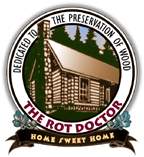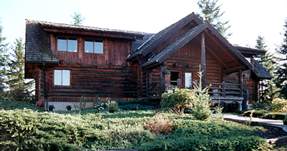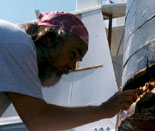Home > Log Home

Log Homes
Welcome log home owners and prospective owners. You are a unique group that has made a lifestyle choice a little outside the ordinary. Log homes require more thought into protection and preservation of the structure of their homes than a typical home owner. Kind of like those of us who live on wooden boats. We all enjoy the special qualities these distinct living arrangements give us, and although there may on the surface seem a world of difference between wood boats and log homes, we do have some very common interests.
and although there may on the surface seem a world of difference between wood boats and log homes, we do have some very common interests.
Chief among these is the protection and preservation of the material — wood — from which our homes are constructed. A normal wood house is a spindly structure compared to a log home. It is quickly put up and can be torn apart for repairs fairly easily. It may not seem easy to the house owner, but compared to what a log home owner must go through to make major structural repairs it is easy.
The average wood home exterior is planked on frames and then covered with paint. Rain and water run easily down the sides, over the laps, and onto the ground. The water has little opportunity to get into the wood. Not so with log homes. The caulking leaks, the end grain on logs absorb water, checks open in the logs and water gets in, gutterless roofs allow water to drop and splash back onto logs, and so forth. Just think a little and you can see many ways water can get into the logs. Add the sunlight, summer heat, certain fungi and bacteria and you have rot. And a rotten log is not easy to replace. Worse yet, the logs often rot from the inside, not outside in, and you don’t even know it until you see a breakthrough or hear that hollow thunk when you rap on the log. End grain, and cracks that can capture moisture are by far the most common ways that moisture causes rot in log homes. In the repair section we get into more detail on this.

Boats have similar problems. Here’s a picture of our Canadian tug, DELTA. The hull was built in 1889, and many of the original timbers are still in place. The planks are 2″ thick and made of fir. She has large timbers in her, and some of these have rotted. If you are interested, you can go to our Rotten‘Zine and see how we repaired the large horn timber. Every piece of bare wood we can get at and all new wood going onto DELTA is saturated with penetrating epoxy. We’re preserving what we have and protecting what we add.

Doctor Rot has over 26 years experience with repairing and restoring bad wood.
A quality penetrating epoxy, applied correctly, is the key to repairing existing damage, and preventing future damage. You can see test results by clicking here. We have had decades of experience in dealing with rot in all kinds of situations. Please check out the rest of our log home section for the techniques and products that will make a durable repair, or lasting prevention in your log structure. We would be happy to discuss your situation via email or phone. Images are not necessary, but can be quite useful. Please send them to our main email, drrot@rotdoctor.com.
With the exception of caulk, which can keep moisture out of the log, what is done to the surface is largely a cosmetic issue, and has little effect in preventing rot. We do not sell or even have strong opinions about final sealers/finishes and other products that are part of the log home experience. We suggest you contact your log home products supplier for any information on these products, or a log home architect/builder for questions regarding construction or reconstruction.
